First and foremost, my biggest piece of advice is do not take "your child might not be able to..." as an excuse not to try something. It may sound like a glass-half-full-vs-half-empty thing, but "might not" also means "might." You just don't know what your kid can or can't do, so, as long as it's not actually dangerous, let them try! See what they can do and then adapt the activity as needed. Your child will always surprise you.
Bracing and therapeutic garments
Mermaid pants: You can buy these pre-made, but I made a pair myself out of some lycra fabric (sew it into a tube and stitch through the middle at one end to make leg tubes). The point was to help keep the hips and knees in alignment as she was learning to crawl. They really helped with getting into a true hands-and-knees crawl stance, though she obviously couldn't crawl in them with her legs held together. We used them from about 6-9 months old I think.
Neoprene shorts: We really didn't use these a whole lot, but they were the recommended next step after the mermaid pants. They're made out of stiff neoprene, but have actual separate legs instead of the tube shape of the others. They were a major pain to get on her because they need to be tight-fitting, but they don't have any stretch to them at all (we had to bounce her into them, which she thought was hilarious). Because they're pretty stiff, they don't really work well for crawling, but they do offer some hip support for standing. Maybe if we had used them more often, they would have broken in and been softer for crawling.

AFOs (Ankle Foot Orthotics): Addy got her first pair right after she got her stander and she's outgrown them about every 8-9 months or so (she's on her 3rd pair right now). The 2nd and 3rd ones were fabricated by an off-site vendor that is very popular with some people and not at all popular with us. I plan to really push for ones that are made in-house by our orthotist (or at least by a different off-site vendor) this fall.
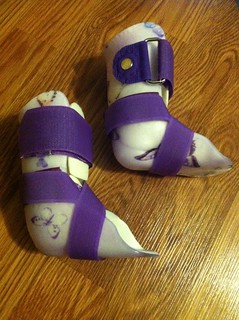
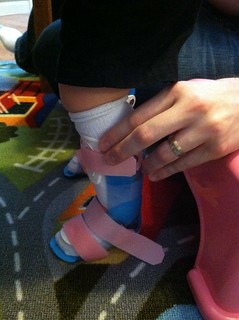
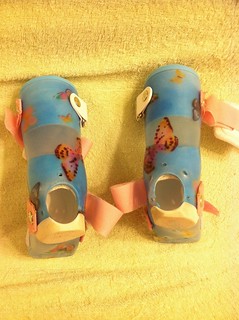
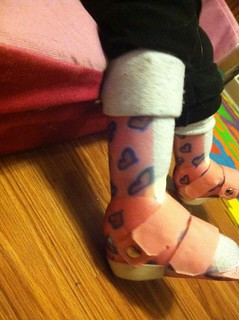
Therapy Suiting: This was recommended as a next step after the neoprene shorts, but we didn't end up pursuing it. It's a body suit with special straps that help to position and/or support the patient. The brand that was recommended is quite expensive and comes with a high frustration quotient. It's intended to be worn under clothing (and diapers), which may or may not be ideal for all patients.
Knee Immobilizers: We used these a lot this spring to help keep Addy's legs stretched out after her surgery and to help get her standing before the KAFOs were fabricated. We also used them for when she wanted to walk out in the community until we noticed that she was developing tibial torsion; she almost exclusively uses the KAFOs for walking now.
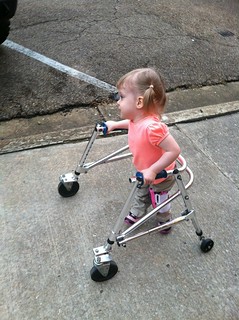
KAFOs (Knee Ankle Foot Orthotics): She got her first pair this spring, following the dual tendon releases. To me Addy's look like HKAFOs (Hip Knee Ankle Foot Orthotics), but I know the Rx we got said KAFOs with drop lock hinges and a belt. We use these all the time now (as in, most days Addy is in her Ks more than her AFOs). They aren't super convenient for walking when we're out and about--she really needs to lay down to get them on correctly and it just takes a few minutes to get all of the straps done up and shoes back on, which is why the knee immobilizers were so great--but they do such a good job of supporting her and keeping her legs aligned correctly. The knee joints on hers have what's called a drop lock; it's a little metal piece that can float down to lock the hinge in place. The hip joints are just hinged with no locks to them. We usually leave the left knee locked, but use a piece of tape to hold the right side in an unlocked position (Addy's left leg is much weaker than the right, so she needs extra support on that side).
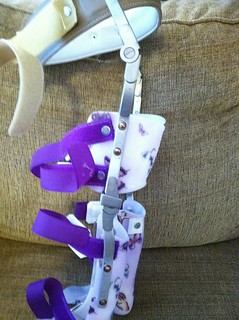
Equipment
Exercise ball: Addy still loves to sit and bounce/rock on her gigantic yoga ball. If you look carefully, you can find ones that are latex-free, but you do have to look. It builds core strength and provides good vestibular input. You can also use it for standing and weight bearing by laying over the ball on your stomach and slowly rock the ball back until your feet touch the floor.
Mobile Stander: Addy got hers when she was about 11 months old--around the time able-bodied kids start pulling up to stand. Hers had big wheelchair-style wheels to it, so she could propel herself around the house (which she learned to do with amazing precision!). Standing is just such a "normal" activity and it does great things for the vestibular system, helps to stimulate bone growth, and having kids at eye-level with their peers is fantastic for their social and verbal development. So much good stuff comes from standing! We attached a standard-issue bike basket to the front of the stander so that Addy could tote toys, books, etc around with her.
Gait Trainer: We used the gait trainer for a relatively short amount of time, but I really think it was the key to getting Addy walking. The brand we had comes with all kinds of accessories and features, so it's really useful across a wide range of diagnoses/needs. It's also kind of overwhelming to try to figure out exactly which settings and accessories you need at any particular time, but it's a fantastic piece of equipment once you find that magic combination. The thing to remember is that as you make progress with strength/balance/endurance/etc, then adjust the equipment to meet the current needs.

(Before surgery)

(3 weeks after surgery)
(6 weeks after surgery)
(3 months after surgery)
Walker: After we got the KAFOs, it seemed like Addy really found the bulk of the gait trainer plus Ks to be too much, so we traded in the gait trainer for a light-weight walker (not unlike the kind adults use, just sized for a smaller person). The one we use is a posterior walker--the frame comes around behind the patient--and it has wheels on all 4 feet. The front wheels can either lock straight or swivel; the back wheels can either roll forward/backward or be set to ratchet forward only. Again, the bike basket is an important feature so that Addy can go pick out a book from the book shelf and then take it to a table to read it (or walk with me to the mailbox to help pick up the mail).
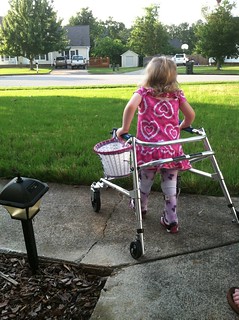
Quad canes ("granny canes"): We tried these once, but Addy is too short right now for the smallest size that our therapy center had. Once she's a little taller, these will probably be the walking aid she'll use.
Parallel bars (or, as Addy calls them, "peril bars"): There are how-to tutorials you can find on the internet for making your own out of PVC or you can order a kit. We're borrowing ours from our therapy center (another family had made them for their child and donated the bars when their child no longer needed them). Ours are about 8.5 feet long, so they take up a LOT of floor space, but it's a good length for walking back-and-forth. Addy uses them at least 3-4 times a week. We decorated ours with butterflies and foam hand prints so she can give her bars high-5s as she's walking.
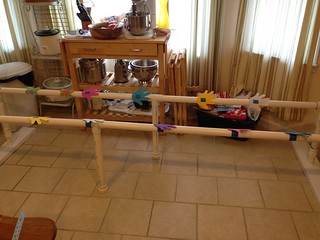
Wheelchair: Yes, this post is mostly about how we've been working on walking but I think it's important to remember that walking is not an all-or-nothing kind of deal. I hadn't realized all of the "kidness" that Addy wasn't getting up to until we started taking her shopping in her wheels. She's able to navigate around the store herself (obviously, we keep an eye on her, but she's able to pick what aisle she wants to go down and what toy or shoes or box of cereal or what-have-you she wants to check out). Your insurance company may disagree, but working on walking does not mean you don't also need to use a wheelchair some (or even most) of the time.
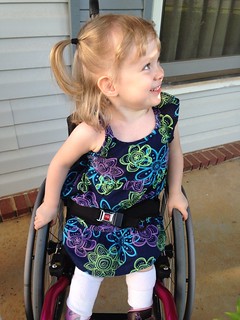
Activities
Ups (a.k.a., sit-to-stands or squats): We used a small stepstool for a bench, parked it and Addy in front of the sofa, and put an irresistible toy just out of reach to encourage her to stand. Addy now does this at the parallel bars by standing with both hands on the same bar and doing squats.
Sofa climbing: Start by taking one or more cushions off the sofa and put them on the floor in front of the sofa. This provides (1) an intermediate step for climbing onto the sofa and (2) and soft place to land if you fall off the sofa (though a safe technique for getting down is a good thing to work on, too). After floor-to-cushion-to-sofa-frame is mastered, take away the cushion so you're going straight from the floor to the sofa frame. Finally, just climb straight from the floor to the sofa (with cushions on the seats like they're supposed to be).

Marching: Either standing on the floor or sitting on a stool, get the legs moving in a marching pattern.
Godzilla attack (and variants): Either standing on the floor or sitting on a stool, stomp on or kick at something that causes a reaction (bubbles, a tower of blocks, toy bowling pin, any toy that lights up or plays a song when you hit a button, your hand--be super dramatic about it because kids love slapstick humor). Growl like Godzilla. Light-up shoes are also effective.
Booty bumps (a.k.a., bridge): Lay on the floor on your back, knees bent, feet flat on the floor. Push up with your legs/abs to raise your backside up off the ground (may need someone to help hold your feet on the floor). If you have a small toy car/truck, try to hold your backside up off the ground long enough for the car to be rolled along under the "bridge" (just be sure you don't accidentally land on the car while it's under you--ouch!).
Treadmill therapy: This was an out-patient therapy we did at our therapy center, but not all centers offer it. It's a harness system that suspends the patient over a treadmill, which allows the therapist to stay seated while helping manipulate the patient's legs in a proper gait pattern. We did 6 weekly sessions when Addy was roughly 18 months old.
Standing at a table/easel: A coffee table at the right height for standing and coloring, painting, reading, playing trains, playing play-doh, etc. A sand and water table is the same idea, though perhaps a bit more messy.
Basketball (or Snaps In The Box): Addy in the gait trainer, starting about 3-4 feet away from me, me holding a small toy for her to come get and then throw into a box (or a ball to throw through a basketball hoop). Simple, but effective.
Cruising: It's so "normal" you almost forget that it's therapeutic. Just like a toddler will cruise the furniture while they transition from standing to walking, it's good for later walkers, too.
Climbing stairs: We have a 2-story house, so every night at bedtime we climb the stairs.
Decorating the patio doors: We have patio doors from the living room out to the back yard, so I got some vinyl stick-ums for Addy to be able to decorate the windows.
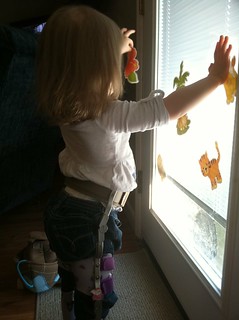
Playhouse: Santa brought a playhouse for Christmas last year. It lived in the living room until it got warm enough to take it outside. Now that it's finally cooling off again, we're playing with it. It has two sides that swing open so you can walk (or roll!) all the way through, and there are lots of doors to walk through and shelves to be able to hold on while you stand/walk/cruise/pull up/etc.
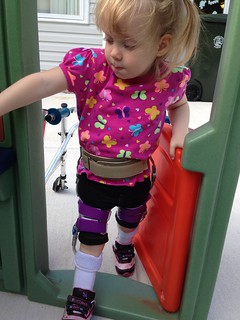
Golf: Helps work on balance, confidence, something fun to do while standing (or sitting in a wheelchair, by the way).
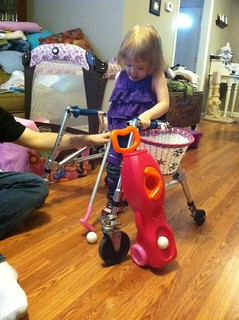
Ready, Steady, Blast-off: I put my arms out on either side of Addy and let her steady herself. When she's ready (and I really think having her decide when she's ready is what's important with this game), she lets go and we take turns counting down from 10 with an exciting "BLAST OFF!" at the end. It's silly, but it's fun. It really got started with Addy standing at the coffee table, trying to psych herself into balancing by herself by telling herself "Ready... Steady... Ready... Steady..." as she would let go of the table briefly.
Yoga/Dancing: Addy really enjoys dancing, so I had taught her how to do "ballet" (really it's just squats with her hands held over her head). I also looked up some kid-friendly yoga poses--her favorites are the tree pose (arms up over your head and sway back and forth) and the rainbow pose (arms up over your head and lean to one side like the arc of a rainbow). Whether doing yoga or dancing, she needs help to stay balanced while standing. If we do seated poses, then obviously we could actually both do them together. Addy also really like Dora, much to my chagrin, but there are several episodes where there are little dances that she likes to do. "Little Einsteins" is another show that has some kind of simple dancing in every episode, and PBS usually has some kind of "get up and move" segment between the kids shows.
Gymnastics: We haven't tried it yet, but I have heard that gymnastics can do wonders for body-awareness, mobility, strength, etc. There is a gym in our area that I know works with special needs kids. I need to give them a call soon to see when they have classes opening up!